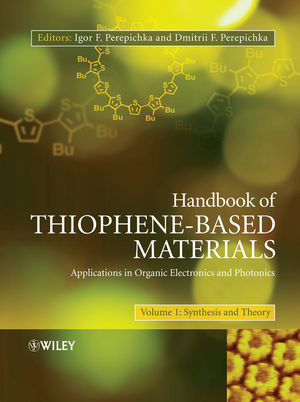Handbook of Thiophene-Based Materials: Applications in Organic Electronics and Photonics, 2 Volume SetISBN: 978-0-470-05732-2
Hardcover
910 pages
August 2009
 |
||||||
Preface
List of Contributors
Volume One: Synthesis and Theory
1 Functional oligothiophene-based materials: nanoarchitectures and applications
Amaresh Mishra, Chang-Qi Ma, José L. Segura and Peter Bäuerle
1.1 Introduction
1.2 Functionalized oligothiophenes
1.3 Fused thiophenes
1.4 Macrocyclic thiophenes
1.5 Dendritic and hyperbranched oligothiophenes
1.6 Conclusions and prospects
Acknowledgments
References
2 Synthesis, characterization and properties of regioregular polythiophene-based materials
Paul C. Ewbank, Mihaela C. Stefan, Geneviève Sauvé and Richard D. McCullough
2.1 Introduction
2.2 Consequences of regiochemistry
2.3 Synthesis of regioregular polythiophenes
2.4 Purification and fractionation
2.5 Molecular characterization
2.6 Solid-state studies
2.7 Block copolymers containing regioregular polythiophenes
2.8 Conclusions
References
3 Fused oligothiophenes
Peter J. Skabara
3.1 Introduction
3.2 Synthesis and molecular properties of fused oligothiophenes
3.3 Conclusion
References
4 Thiophene-S,S-dioxides as a class of electron-deficient materials for electronics and photonics
Giovanna Barbarella and Manuela Melucci
4.1 Introduction
4.2 Electrochemical and photoluminescence properties
4.3 Application in devices
4.4 Conclusion
Acknowledgments
References
5 Synthesis and properties of oligo- and polythiophenes containing transition metals
Michael O. Wolf
5.1 Introduction
5.2 Transition metal-containing oligothiophenes
5.3 Electropolymerization and properties of polymers
5.4 Conclusion and outlook
References
6 Selenophenes as hetero-analogues of thiophene-based materials
Tetsuo Otsubo and Kazuo Takimiya
6.1 Introduction
6.2 Selenophene-based conducting materials
6.3 Selenophene-based electroactive materials
6.4 Selenophene-based OFET materials
6.5 Conclusion
References
7 Energy gaps and their control in thiophene-based polymers and oligomers
Miklos Kertesz, Shujiang Yang and Yonghui Tian
7.1 Introduction
7.2 Oligomer vs PBC calculations of the bandgap
7.3 Gap and connectivity
7.4 Bandgap affected by an aromatic vs quinonoid valence tautomerism
7.5 Is a small bandgap thiophene polymer attainable?
7.6 Gaps of ladder-like PThs
7.7 Substitutions and other factors influencing the gap
7.8 Conclusion
Acknowledgment
References
8 Theoretical studies on thiophene-containing compounds
Sanjio S. Zade and Michael Bendikov
8.1 Introduction
8.2 HOMO–LUMO gap and bandgap calculations
8.3 Nature of charge carriers
8.4 Effect of substitutions on different properties
8.5 Twisting (inter-ring deviation from planarity) in oligo- and polythiophene
8.6 IR and Raman spectra
8.7 UV–Vis spectra
8.8 Quinoid oligothiophene
8.9 Cyclic oligothiophene
8.10 New compounds with tailor-made properties
8.11 Conclusion
Acknowledgments
References
Volume Two: Properties and Applications
9 Electrochemistry of oligothiophenes and polythiophenes
Philippe Blanchard, Antonio Cravino and Eric Levillain
9.1 Introduction
9.2 Electrochemistry
9.3 Spectroelectrochemistry
9.4 Conclusion
References
10 Novel photonic responses from low-dimensional crystals of thiophene/phenylene oligomers
Hisao Yanagi, Fumio Sasaki, Shunsuke Kobayashi and Shu Hotta
10.1 Introduction
10.2 Low-dimensional crystals of thiophene/phenylene co-oligomers
10.3 Amplified spontaneous emission
10.4 Stimulated resonance Raman scattering
10.5 Pulse-shaped emission with time delay
10.6 Conclusion
Acknowledgments
References
11 Novel electronic and photonic properties of thiophene-based oligomers
Shu Hotta
11.1 Introduction
11.2 Materials and molecular alignments: thin films and crystals
11.3 Charge transport: FET device applications
11.4 Photonic features: laser oscillation
11.5 Implications of the optoelectronic data of the crystals
11.6 Conclusion and future prospects
Acknowledgments
References
12 Liquid crystalline and electroresponsive polythiophenes
Kazuo Akagi
12.1 Introduction
12.2 Synthesis and properties of LC polythiophene derivatives
12.3 FLC Polythiophene derivatives
Acknowledgments
References
13 Self-assembly of thiophene-based materials: a scanning tunneling microscopy perspective
Clara Santato, Fabio Cicoira and Federico Rosei
13.1 Introduction
13.2 STM studies of thiophene-based materials
13.3 Conclusions and perspectives
References
14 PEDOT – properties and technical relevance
Knud Reuter, Stephan Kirchmeyer and Andreas Elschner
14.1 Introduction
14.2 Synthesis
14.3 Properties
14.4 Processing
14.5 Uses
14.6 Conclusion
Acknowledgments
References
15 Polythiophenes as active electrode materials for electrochemical capacitors Daniel Bélanger
15.1 Introduction
15.2 Electrochemical capacitors
15.3 Polythiophene derivatives
15.4 Types of electrochemical capacitors
15.5 Performance and prototypes
15.6 Conclusion
Acknowledgments
References
16 Electroactive oligothiophenes and polythiophenes for organic field effect transistors
Antonio Facchetti
16.1 Introduction
16.2 Field effect transistors
16.3 Thiophene-based oligomers for OFETs
16.4 Thiophene-based polymers for OFETs
16.5 Conclusions and outlook
References
17 Thienothiophene-containing polymers for field effect transistor applications
Iain McCulloch and Martin Heeney
17.1 Introduction to organic electronics
17.2 Organic field effect transistors
17.3 Organic semiconductors
17.4 Thienothiophene polymers
17.5 Conclusion
References
18 Photovoltaics based on thiophene polymers: a short overview
Suren A. Gevorgyan and Frederik C. Krebs
18.1 Introduction
18.2 Processing at higher levels
18.3 Thermal processing to alter morphology
18.4 Solvent vapor treatment to alter morphology
18.5 Thermocleavage
18.6 Other methods to control morphology
18.7 Conclusion
Acknowledgments
References
19 Thiophene-based materials for electroluminescent applications
Igor F. Perepichka, Dmitrii F. Perepichka and Hong Meng
19.1 Introduction
19.2 General synthetic routes to PTs
19.3 Thiophene homopolymers
19.4 Thiophene oligomers
19.5 Copolymers of thiophenes with other conjugated moieties
19.6 Oligomers and polymers with thiophene-S,S-dioxide moiety
19.7 Thiophene materials for unconventional and advanced electroluminescent applications
19.8 Conclusions
Abbreviations
References
20 Thiophene-based electrochromic materials
Muge Acik, Michael A. Invernale and Gregory A. Sotzing
20.1 Electrochromism and electrochromics
20.2 Electrochromism in polythiophene derivatives
20.3 Organic versus inorganic
20.4 Electrochromics in applications
20.5 Conclusion
References
21 Photoresponsive thiophene-based molecules and materials
Luc Ubaghs, David Sud and Neil R. Branda
21.1 Introduction
21.2 Photochromism in single crystals
21.3 Photochromism in amorphous films
21.4 Photochromism in polymers
21.5 Photochromism on metal surfaces
21.6 New architectures
21.7 Conclusion
References
22 Chemical and biological sensors based on polythiophenes
Hoang-Anh Ho and Mario Leclerc
22.1 Introduction
22.2 Different types of polythiophenes for chemical and biological sensors
22.3 Chemical sensors
22.4 Biological sensors
22.5 Conclusions
References
Index



